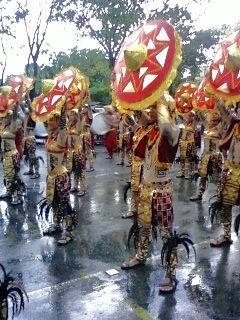 | ||
Aliwan Fiesta is an annual event that gathers different cultural festivals of the Philippines in Star City Complex in Pasay City wherein contingents compete in dance parade and float competitions, as well as in a beauty pageant. Organized by Manila Broadcasting Company (MBC) together with Cultural Center of the Philippines (CCP) and the cities of Manila and Pasay, the event is dubbed as "The Mother of All Fiestas," with prizes totaling to P3 million (roughly US$70,000). Aliwan Fiesta, which began in 2003, aims to showcase the different Filipino cultures and heritage not only to the people in Metro Manila but also to the rest of the world. The contingents, meanwhile, aim to promote their respective regions both economically and tourism-wise. It was originally organized as a visual extravaganza for the Christmas season, but it has since been held during the summer months of either April or May. Aliwan is a Tagalog word for "entertainment" or "amusement." For 2010, the colorful banner at the Roxas Blvd. entrance proclaimed the fiesta as THE PHILIPPINES GRANDEST FIESTA.
Contents
Competition
Aliwan Fiesta is divided into three categories: Cultural Street Dance Competition (the main event), Float Parade, and Reyna ng Aliwan (Queen of Entertainment/Amusement) beauty pageant. Each of the country's 18 regions have the option to send up to two contingents representing its respective cultural festival, as well as an option to send a representing float and or beauty pageant contestant. However, the roster of entries for the cultural dance and float competitions are limited. In 2008, the number of slots for cultural dance was increased from 20 to 24 groups, which was completed as early as January. Each contingent in the cultural street dance competition—totaling up to 100 dancers as well as hundreds of musicians and support staff members—have undergone stringent elimination cycles during various local festivals before being chosen to compete in Aliwan Fiesta. The highlight of the event is when all competing festivals show off their dance skills while parading for four kilometers (about 2½ miles) along Roxas Boulevard from Quirino Grandstand to Aliw Theater grounds located near CCP. The festivals range from the well-known such as Sinulog of Cebu City, and Panagbenga of Baguio City, to the obscure but just-as-interesting feasts like Alikaraw of Hilongos, Leyte, Padang-Padang of Parang, Shariff Kabunsuan, and Pamitinan Festival of Rodriguez, Rizal. Side events also include a bazaar featuring different regional products, a photography contest, an inter-scholastic dance competition (interpreting dance tunes played on MBC radio stations), Filipino street games, and a fireworks display.
Meanwhile, the participating floats are only allowed to use local textiles, produce, flowers, and other products specific in their representing city in decorating the vehicles. Each float, portraying local folklore and indigenous traditions, is topped by a participant of Reyna ng Aliwan serving as muse. The province of CEBU holds the record of the most number of wins in the Reyna ng Aliwan Pageant a total of six consecutive times from Reyna ng Aliwan 2009 until 2014. Last Aliwan Fiesta 2014 another cebuana beauty won the Reyna ng Aliwan 2014 title and a record sixth peat set by Steffi Aberasturi of Cebu City. The beauty pageant contestants have competed a day before the parade.
The top ten contingents in the cultural dance and float competitions receive cash prizes, with the top float winner receiving P500,000 (roughly US$11,000) and the winning cultural dance group getting P1 million (about US$23,000) as well as the bragging rights of becoming the champion of Aliwan Fiesta. Meanwhile, the Reyna ng Aliwan receives P100,000 (roughly US$2,300).
By wins
Reyna ng Aliwan Winners
Cebu has won the crown in six consecutive years (2009, 2010, 2011, 2012, 2013, 2014) followed by Baguio (2005, 2006) then Davao, Bulacan and Laoag.
Coffee table book
MBC presented a coffee table book in 2008 entitled Aliwan Fiesta: Celebrating Life In These 7,107 Islands. It was documented by cultural affairs specialist Susan Isorena-Arcega, featuring various photographs taken during Aliwan Fiesta's first five years. The book aims to tackle the Filipino's festive psyche, the multi-pronged treatise on what the Philippine festivals are rooted in, and the display of cultural heritage through dance and craftsmanship.
